GAT 034 Saskia Bos
Teaching Art in Times of Armed Conflict: Part 2

Russia’s military invasion of Ukraine on February 24, 2022 took the world by surprise. Our contemporary world is beset by international conflicts, wars, economic difficulties, migration issues, and other constant problems. How have artists who lived during disturbing times in history confronted these themes? On August 8, 2022, Amsterdam-based art historian, critic, and independent curator Saskia Bos made a talk entitled “Teaching Art in Times of Armed Conflict. The following are excerpts from the talk.
Edited by Ishii Jun’ichiro (ICA Kyoto)
to the “Teaching Art in Times of Armed Conflict: Part 1“
A few paintings by Philip Guston «In prison» 1968.
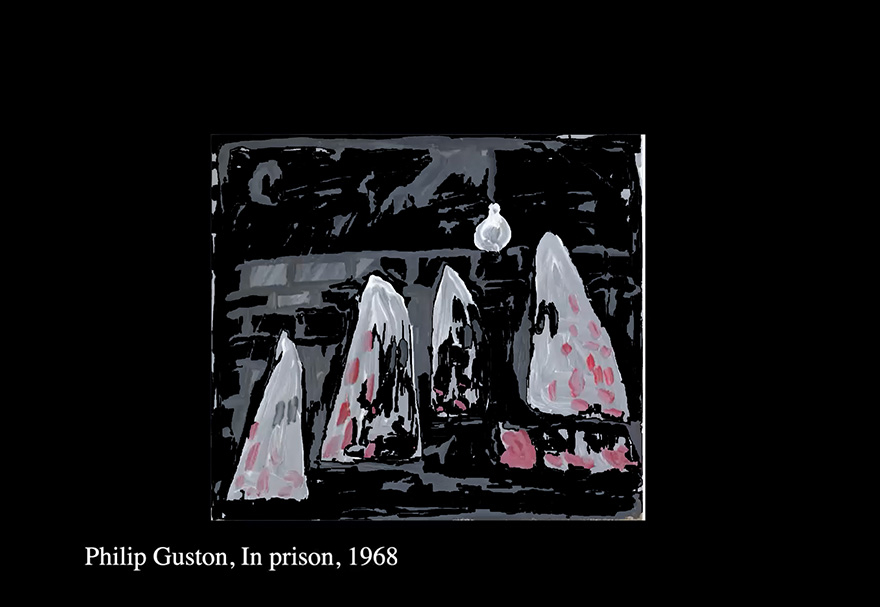
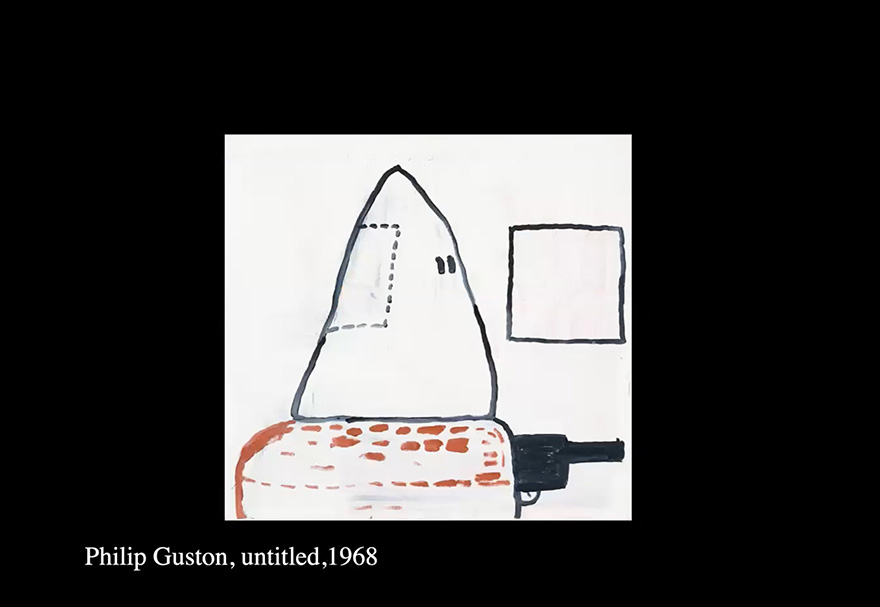
The reason I’m showing this, is about the KKK. There were terrible, extreme right-wing people who wear those uniforms, which have those holes to lookout, they are extremely racist. That is the reason that a show about Philip Guston has been censored. At this moment, to show the works of Philip Guston for a museum seem to be really difficult.
Of course, as a Jew, Guston was quite aware that racism is one of the worst things in life. He was just depicting it but at some times it doesn’t seem to be possible. Just after the murder of George Floyd in America (2020), it seemed to be difficult for the museum to show this work.

This is called «American People Series #20: Die» from 1967. Not so far removed from the Guston that I just showed you.
The big difference is Guston is a white man, and that this is a black woman artist.
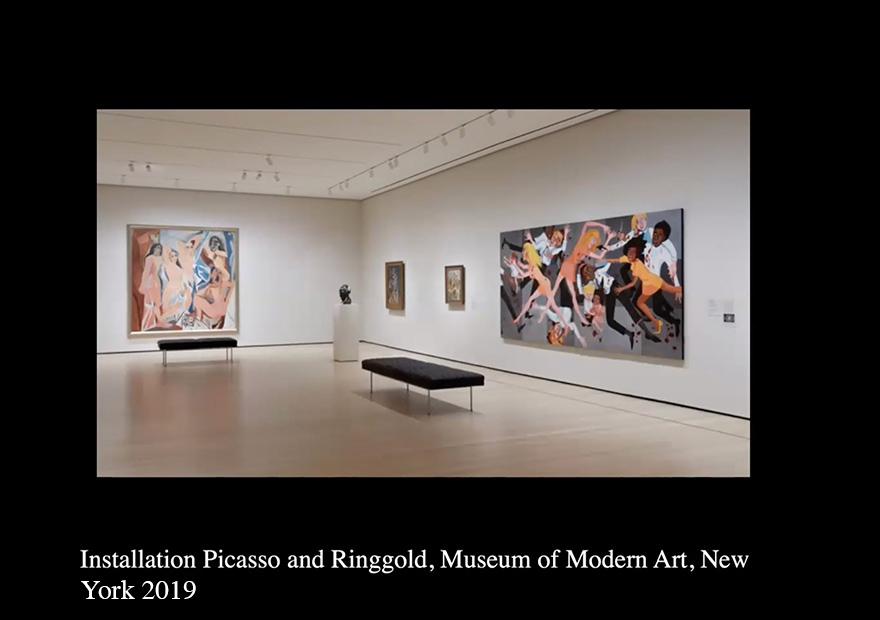
Only two or three years ago, there was a re-hang of the Museum of Modern Art. And in the Museum of Modern Art, you see in the back of the picture, you see «Les Demoiselles d’Avignon» by Picasso and that was always considered to be avant-garde because it was dealing with Africa.
For the first time, they tried to comment on the art history a little bit by putting Faith Ringgold from 1967 in the same room, and all the newspapers in Europe and probably here as well in Japan, we’re talking about how can you do that? why did they do that?

It is not only because Faith Ringgold herself here in painting «Picasso’s Studio» and she loves Picasso. She is here, you see Picasso, you see Faith Ringgold, probably posing nude.
The point to talk about this now, because if museums are rehanging their collections in function of what’s happening in society today with the George Floyd murder, and with all the other debates that are going on, that’s interesting to look at but let’s not forget that at the same time, they are censoring, they have censored for two years the Philip Guston’s show which in the end was done.
There is a double sword there. You want to be right in saying, “okay, let’s face it. We have maybe not appreciated artists like Faith Ringgold enough.” But to take it away out of fear ? Surely it was because of fear of the public reaction that they didn’t want to open the Guston show. They got a lot of aggressive reactions to that from journalists, from critics who said, how can you censor and self-censor.
And that is something we’ve been talking about a lot in the (Kyoto University of Arts, graduate school, Global Seminar) classroom, self-censorship, censorship, in connection to sexism and racism. Sexism being that you don’t want to show women art or art from homosexual people, artists that you’re a sexist about, and racism. Obviously, we all know that it has to do with ethnicities and where they come from.
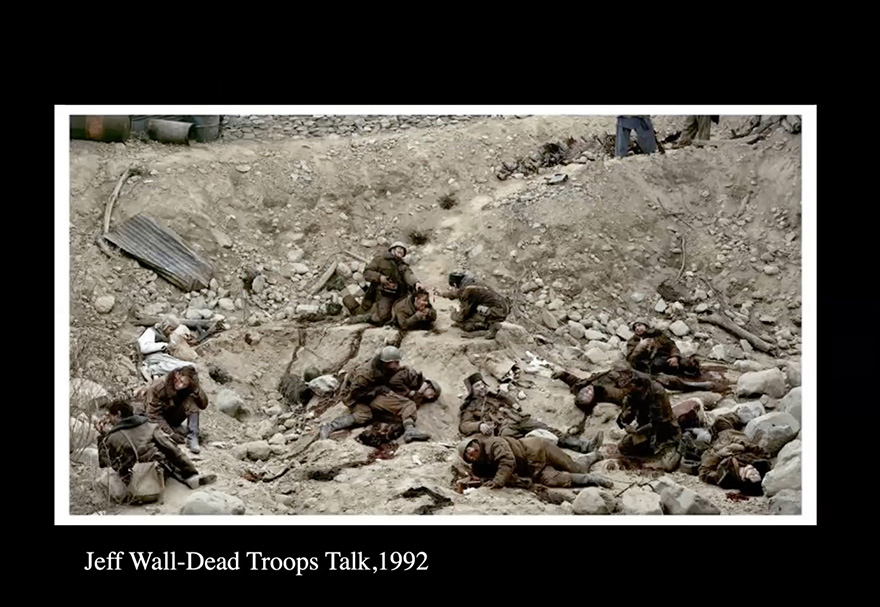
«Dead Troops Talk» is 1992, Jeff Wall, Canadian artist re-enacts things. He is fascinated by historical painting by the 19th century by the idea of the panorama, he loves all those things and he makes art. That is a “mise-en-scène”, it’s put together, it’s created. It’s not a photograph, it’s a set photograph, it’s a staged photograph.

We’re back at Robert Capa, but for very different reasons. Robert Capa one is just to show something very effectively. This also is trying to show something very effectively as an artist, an artist not to be in Life Magazine but to try to analyze what is happening with our emotions.

Maybe you’ve heard of Walid Raad, he used to call himself the Atlas Group. This is from 2001, which is of course, very close to the time that we have the World Trade Center bombing in New York and the artist himself is originally from Beirut, from Lebanon, and he lived there. As a kid, he was impressed and impacted by the Lebanese wars. The Lebanese wars, you can say they never ended because they started in officially 1975 until 1990 but in 2006, they pick up again, and I think it’s never been calm around there.
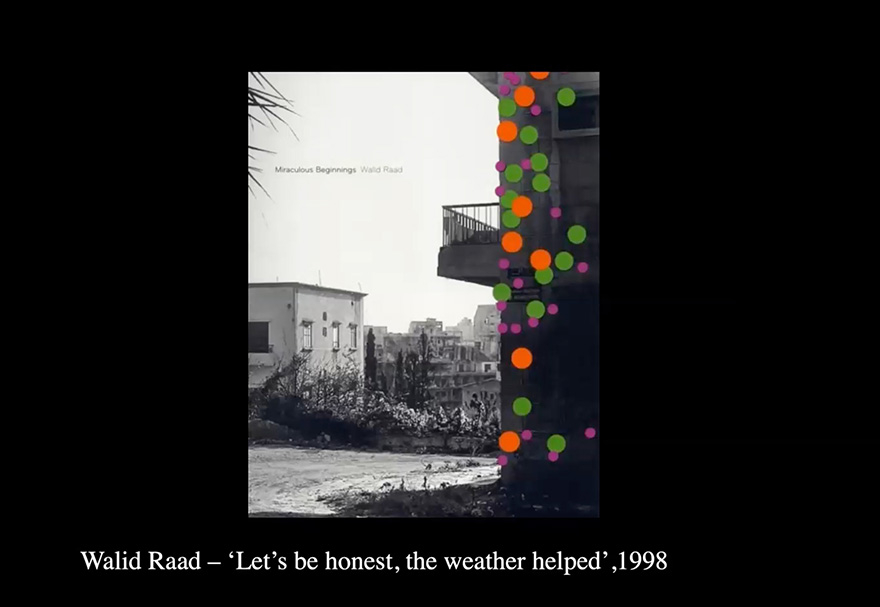
This work is a little earlier, it’s called Let’s Be Honest, the Weather Helped. It’s from 1998. It’s also the cover of a book that I have.
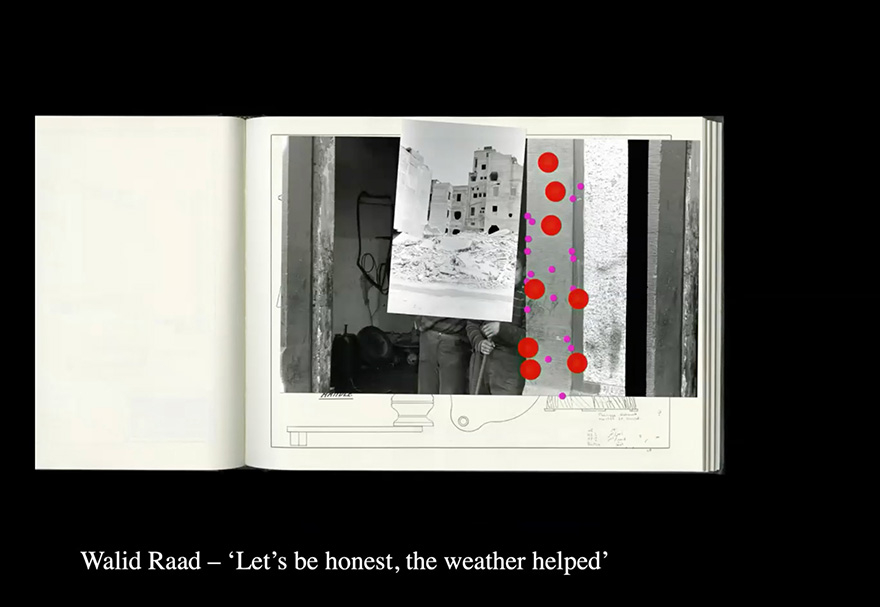
I just made this slide. The book is called “Miraculous Beginnings”. If you’ve been following the news, as we all do, I have it from the page in the New York Times, the printed paper and I photographed it for you because this made me think of Walid Raad’s piece.

This is Kyiv Ukraine this year.
◉
I would like to conclude my talk and my presentation with one work that I can only describe to you and then I have to read the text.
It is 2002 and I’m visiting the Documenta made by Okwui Enwezor and I’m coming to room, allocated room in the Fridericianum, which is one of the main buildings in Kassel where they hold the Documenta and I’m in a very long corridor. I don’t understand it. I see a few texts.
At the end of the corridor, there is a flashing blinding light and it hurts my eyes. At that point, I walked back and I started reading the text.
The piece is called «Lament of the Images 2002». It’s now in the MoMA and it was being collected and as a gift by Patricia Phelps de Cisneros who is supporting her artists.
The artist is Alfredo Jaar, he is from Chile. Alfredo Jaar made that corridor, but he worked together with somebody I know. I only found out later, who is called David Levi Strauss. David Levi Strauss is the writer of three texts, of which it is too much to read you everything, all the three but I’ll just do one because it’s already very impressive. It’s called «Cape Town, South Africa, February 11, 1990».
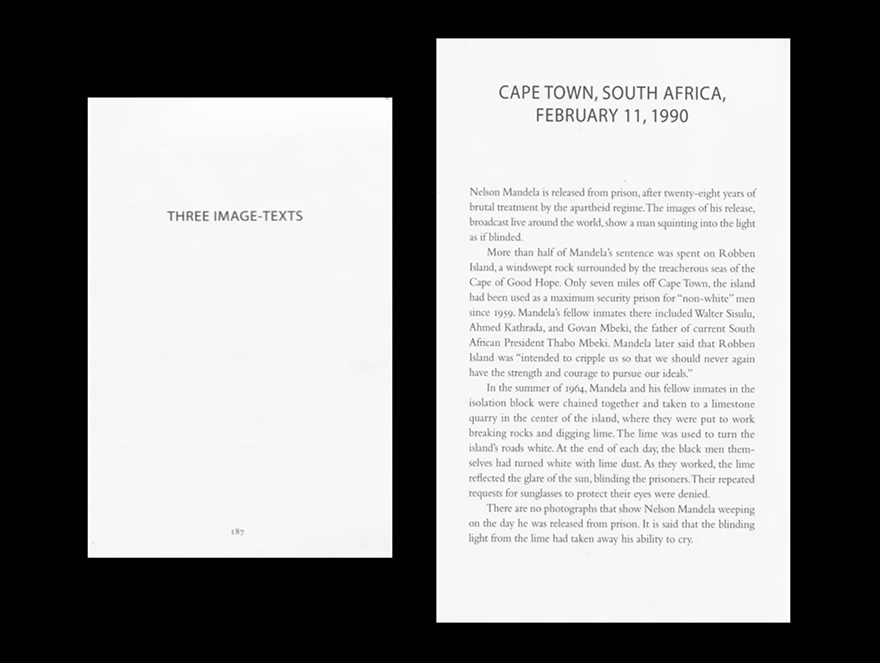
“Nelson Mandela is released from prison, after twenty-eight years of brutal treatment by the apartheid regime. The images of his release, broadcast live around the world, show a man squinting into the light as if blinded.
More than half of Mandela’s sentence was spent on Robben Island, a windswept rock surrounded by the treacherous seas of the Cape of Good Hope. Only seven miles off Cape Town, the island had been used as a maximum security prison for “non-white” men since 1959. He was there with a few others and Mandela later said that Robben Island was “intended to cripple us so that we should never again have the strength and courage to pursue our ideals.”
In the summer of 1964, Mandela and his fellow inmates in the isolation block were chained together and taken to a limestone quarry in the center of the island where they were put to work breaking rocks and digging lime. The lime was used to turn the island’s roads white. At the end of each day, the black men themselves had turned white with lime dust. As they worked, the lime reflected the glare of the sun, blinding prisoners. Their repeated requests for sunglasses to protect their eyes were denied.
There are no photographs that show Nelson Mandela weeping on the day he was released from prison. It is said that the blinding light from the lime had taken away his ability to cry.”
Thank you for listening to me. Think of art and poetry as helpful in coping with all the disasters of the world.
Saskia Bos (Art Historian, Curator, Critic)
Bos is an independent curator and critic of contemporary art, living in Amsterdam, the Netherlands. She has a long experience in exhibition making, teaching and in arts administration both in Europe and in the US; she is also the founding director of De Appel’s curatorial program, and has been the Dean of the School of Art at the Cooper Union, New York, between 2005 and 2016. She is currently on the Board of CIMAM(International Committee for Museums and Collections of Modern Art).
Bos has produced many international projects and collaborated with many institutions: one of her first international projects was editing the catalogues for Documenta 7 in Kassel and assisting the curatorial team of Rudi Fuchs. Other projects include: Sonsbeek ’86, Arnhem, The Netherlands; Venice Biennale 1988 (Co-curator of Aperto); Biennale Sao Paulo (Dutch Commissioner) 1998; 2nd Berlin Biennial, 2001 and 3rd Skulptur Biënnale Münsterland, 2003.
In 2009 she curated the Dutch pavilion at the Venice Biennale.
* This talk was held at the Kyoto University of Arts on August 8, 2022.